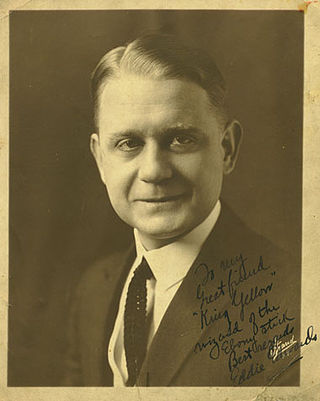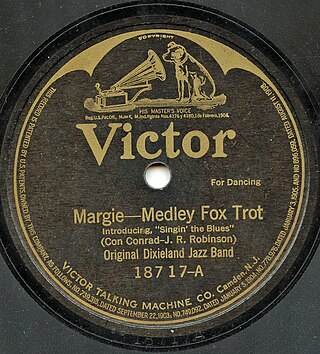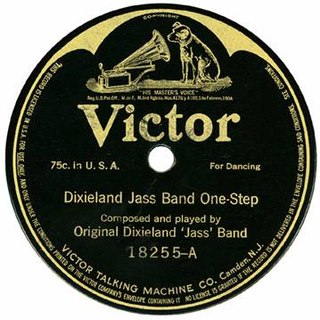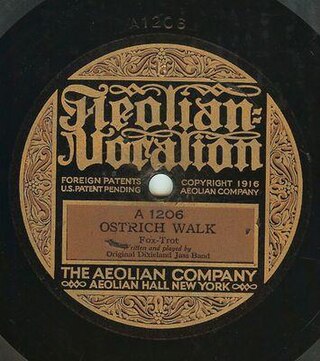
The Original Dixieland Jass Band (ODJB) was a Dixieland jazz band that made the first jazz recordings in early 1917. Their "Livery Stable Blues" became the first jazz record ever issued. The group composed and recorded many jazz standards, the most famous being "Tiger Rag". In late 1917, the spelling of the band's name was changed to Original Dixieland Jazz Band.

Dominic James "Nick" LaRocca, was an American early jazz cornetist and trumpeter and the leader of the Original Dixieland Jass Band, who is credited by some as being "the father of modern jazz". He is the composer of one of the most recorded jazz classics of all-time, "Tiger Rag". He was part of what is generally regarded as the first recorded jazz band, a band which recorded and released the first jazz recording, "Livery Stable Blues" in 1917.

Lawrence James Shields was an early American dixieland jazz clarinetist. He was a member of the Original Dixieland Jazz Band, the first jazz band to record commercially.

Alcide Patrick Nunez, also known as Yellow Nunez and Al Nunez, was an American jazz clarinetist. He was one of the first musicians of New Orleans to make audio recordings.

Edwin Branford Edwards was an early jazz trombonist who was a member of the Original Dixieland Jass Band.

"Tiger Rag" is a jazz standard that was recorded and copyrighted by the Original Dixieland Jass Band in 1917. It is one of the most recorded jazz compositions. In 2003, the 1918 recording of "Tiger Rag" was entered into the U.S. Library of Congress National Recording Registry.

Bing with a Beat was Bing Crosby's seventh long play album but his first with RCA Victor. It was recorded at the Radio Recorders "Annex" Studio in Los Angeles and released on vinyl in September 1957. Bing with a Beat is a 1957 concept album where the songs feature "hot" jazz and dixieland arrangements by Matty Matlock, played by Bob Scobey's Frisco Jazz Band.

Henry Walter Ragas was a jazz pianist who was a member of the Original Dixieland Jazz Band, the first jazz band to record commercially.

"Palesteena", or, "Lena from Palesteena", was a 1920 song, with lyrics by Con Conrad, and music by J. Russell Robinson.

"Darktown Strutters' Ball" is a popular song by Shelton Brooks, published in 1917. The song has been recorded many times and is considered a popular and jazz standard. There are many variations of the title, including "At the Darktown Strutters' Ball", "The Darktown Strutters' Ball", and just "Strutters' Ball".

"Margie", also known as "My Little Margie", is a 1920 popular song composed in collaboration by vaudeville performer and pianist Con Conrad and ragtime pianist J. Russel Robinson, a member of the Original Dixieland Jazz Band. Lyrics were written by Benny Davis, a vaudeville performer and songwriter. The song was introduced by the Original Dixieland Jazz Band in 1920 as Victor 78, 18717-A, in a medley paired with "Singin' the Blues". The B side was "Palesteena". The ODJB recorded their instrumental version on December 1, 1920.

"Livery Stable Blues" is a jazz composition copyrighted by Ray Lopez and Alcide Nunez in 1917. It was recorded by the Original Dixieland Jass Band on February 26, 1917, and, with the A side "Dixieland Jass Band One-Step" or "Dixie Jass Band One-Step", became widely acknowledged as the first jazz recording commercially released. It was recorded by the Victor Talking Machine Company in New York City at its studio at 46 West 38th Street on the 12th floor – the top floor.
Dixieland jazz, also referred to as traditional jazz, hot jazz, or simply Dixieland, is a style of jazz based on the music that developed in New Orleans at the start of the 20th century. The 1917 recordings by the Original Dixieland Jass Band fostered awareness of this new style of music.

"Sensation Rag" or "Sensation" is a 1918 jazz instrumental by the Original Dixieland Jazz Band. It is one of the earliest jazz recordings. It is not related to Joseph Lamb's 1908 "Sensation Rag", which is a ragtime piano piece.

"Singin' the Blues" is a 1920 jazz composition by J. Russel Robinson, Con Conrad, Sam M. Lewis, and Joe Young. It was recorded by the Original Dixieland Jass Band in 1920 as an instrumental and released as a Victor 78 as part of a medley with "Margie". The song was released with lyrics by vocalist Aileen Stanley in 1920 on Victor. In 1927, Frank Trumbauer, Bix Beiderbecke, and Eddie Lang recorded and released the song as an Okeh 78. The Trumbauer recording is considered a jazz and pop standard, greatly contributing to Frank Trumbauer and Bix Beiderbecke's reputation and influence. It is not related to the 1956 pop song "Singing the Blues" first recorded and released by Marty Robbins in 1956.

"Dixieland Jazz Band One-Step" also known as "Dixie Jass Band One-Step" and "Original Dixieland One-Step" is a 1917 jazz composition by the Original Dixieland Jass Band released as an instrumental on a 78rpm record, issued by the Victor Talking Machine Company. The song is a jazz milestone as the first commercially released "jass" or jazz song.

Ostrich Walk" is a 1917 jazz composition by the Original Dixieland Jass Band released as an instrumental as an Aeolian Vocalion and a Victor 78. Frankie Trumbauer and Bix Beiderbecke recorded the song in 1927. The song is a jazz milestone as one of the first commercially released "jass" or jazz recordings.
"I'm Coming Virginia" is a song composed in 1926 by Donald Heywood with lyrics by Will Marion Cook. It is often wrongly attributed to vocalist Ethel Waters, who first recorded it on September 18, 1926, with Will Marion Cook's Singing Orchestra. Waters is credited with popularizing it. Cornetist Bix Beiderbecke, pianist Fats Waller and the Paul Whiteman Orchestra featuring Bing Crosby all recorded it in 1927. The song has become a jazz standard performed by Dixieland musicians.
Fidgety Feet is a Dixieland jazz standard, first recorded by the Original Dixieland Jass Band in June 1918. The more acclaimed version is the 1924 recording by The Wolverines, with Bix Beiderbecke. It is not to be confused with the George Gershwin song of the same name that appears in the 1926 musical Oh, Kay!.


















